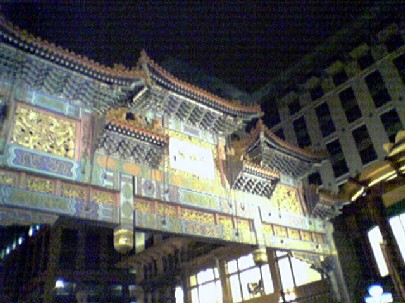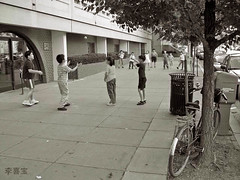Chinatowns on the Decline across the U.S.
 Chinatown arch in Washington, DC. Photo by jgoldmania.
Chinatown arch in Washington, DC. Photo by jgoldmania.It should be no surprise that the Baltimore Sun reports "Once-teeming Chinatowns in decline across country: Migration to the suburbs leads to their demise in Baltimore and other cities." For a long time I have jokenly called DC's Chinatown "Chinablock" and I say that putting chinese letters on the fronts of buildings (Hooters is called "Owl Restaurant" in Chinese) doesn't a Chinatown make.
It happens that last night I was out with some people (after a Zoning Commission hearing) and we were discussing all things Washington, including the demolition of the "old" Washington Convention Center (check out this entry about it from DCist) and one of the people commented that the Convention Center killed Chinatown (the Chinatown Citizens Association signed off on it because they got a new urban brutalist senior citizens home) because I guess there were a couple blocks of Chinatown over there as well.
You'd never have known it today. And, I forgot to mention that I noticed a couple days ago that Da Hua Market, the Asian grocery that opened in Chinatown in the late 1980s, has closed. This must have happened recently, because I know I was in there last year a few times. Ironically, given all the entries I write about supermarkets, had that store done some upgrading of product mix and marketing, it could probably have developed a decent business serving the new residential community that is developing nearby. (The grocery store that opened as part of the Lansburgh development in the late 1980s didn't last very long. It's been a CVS drugstore for many years.)
If you read books by George Pelecanos about Washington in the 1940s and 1950s, clearly Washington had a much more ethnic feel than it does today. Defined neighborhoods of Greeks, Irish, Italians, German-Russian Jews, Chinese, and other ethnic groups--marked by ethnic restaurants, agglomerations of small businesses (like Baltimore's Little Italy), churches, "foreign"-language newspapers and the like--no longer really exist.
 Senior Housing at 6th and H Streets NW, Washington, DC. The wall on H Street is blank and anti-pedestrian on a significant pedestrian thoroughfare. Photo by Li Xie Bao
Senior Housing at 6th and H Streets NW, Washington, DC. The wall on H Street is blank and anti-pedestrian on a significant pedestrian thoroughfare. Photo by Li Xie Bao



0 Comments:
Post a Comment
<< Home